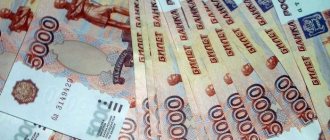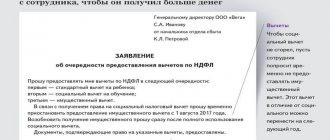A tax deduction for VAT is the amount of input tax by which the taxpayer has the right to reduce the amount of VAT calculated for payment. The procedure for providing such a deduction is regulated by Art. 171 Tax Code of the Russian Federation.
There are a number of conditions, if not met, tax cannot be deducted:
- Purchased resources for which a deduction was claimed must be used in the future in VAT transactions;
- Inventory and materials are accepted for accounting;
- VAT is confirmed by a correctly completed invoice.
Input VAT is accounted for on account 19.
Is there a “safe” VAT deduction amount?
How to assess whether an organization pays enough value added tax? After all, absolute numbers in this regard are completely uninformative. The amount of tax depends on a combination of factors, including the type of activity, profitability, markup, seasonality and many others, including the general economic situation in the country. Therefore, the wording of the question “ how much VAT should I pay so that the tax authorities do not want to come with an audit?” "is itself incorrect.
It is much more correct to ask the question about the share of deductions in the total amount of accrued VAT, because it is this indicator that tax authorities pay attention to. Officially, it is called the share of VAT deductions in the calculated amount of VAT on taxable items.
For the Russian Federation, the threshold value of this indicator as of November 1, 2019 is
87,39%
The size of this indicator for Russia previously, as of August 1, 2019, was 86.93%
For information on the safe share of deductions by region, see below - these are the figures that the local tax office focuses on when checking.
For Moscow, the threshold value of the indicator as of November 1, 2019 is
88,76%
The size of this indicator for Moscow earlier, on August 1, 2019, was 88.08%
Calculation of the share of VAT deductions
What does this indicator mean and how is it calculated? This is nothing more than a percentage of VAT deductions in the amount of accrued tax. To calculate it, you need only two values, which can be found in section 3 of the VAT return. This is line 190 (VAT deductible) and line 118 (VAT accrued).
The indicator is calculated using the following formula:
VAT deductible / VAT accrued * 100%
In order to see the dynamics of this indicator, it is better to take the relevant data from the last four declarations.
The result of the calculation will be a percentage value corresponding to the share of VAT deductions in the total amount of accrued tax. In other words, this value shows what percentage of the accrued VAT the company claims to deduct. It is this that the tax authorities will compare with the threshold indicator in order to draw a conclusion about the degree of tax risks of the company for VAT. If the proportion of VAT deductions according to the taxpayer’s declaration is greater, then this immediately attracts the attention of tax inspectors.
An example of calculating the safe amount of VAT deduction
Let’s assume that during the reporting period, a taxpayer from Moscow paid VAT in the amount of 100,000 rubles.
It is impossible to say whether this is a lot or a little for this organization. But the picture becomes clearer if we calculate the share of VAT deductions:
According to the company’s declaration, for the specified period the amount of calculated VAT, taking into account the restored amounts, is 1,500,000 rubles (
). The tax deduction for the same period amounted to 1,400,000 rubles (
). Substituting these figures into the above formula, we find that the share of VAT deductions in the amount of accrued tax in the period under review was 1,400,000 / 1,500,000 = 93.33% . This is more than the threshold value of 88.76% for Moscow (as of November 1, 2019), which means that the tax authorities have a reason to take the taxpayer into custody.
What should be the amount of VAT in the considered example for Moscow, so as not to attract increased attention from tax authorities?
It can be calculated using the reverse formula: accrued VAT * (100 – safe VAT) / 100 = = 1,500,000 * (100 - 88.76) / 100 = 168,600 rubles.
Based on the criteria used by the Federal Tax Service, the company in our example needs to pay at least 168,600 rubles in VAT in order not to leave the “safe” zone.
What to do if the deduction amount is higher than the recommended standards?
If there is a lot of input VAT and it exceeds the recommended values, 2 options are possible:
- Leave your actual data and wait for a call to the commission;
- Transfer part of the deductions to later periods.
In the first case, an explanatory letter may be attached to the declaration indicating the reasons for exceeding the permissible percentage of the deduction share.
If the organization has chosen method 2, then deductions can be transferred to later tax periods, but no more than 3 years from the date of capitalization of inventory items. Taxpayers have this right since January 1, 2015, and it is regulated by paragraph 1.1 of Art. 172 of the Tax Code of the Russian Federation. The tax is claimed for deduction in the tax period when the company decided to actually declare it. In this case, the incoming invoice is recorded in the purchase book for this particular quarter.
However, there are exceptions to this rule. The tax must be deducted at one time if:
- subsequent sale of assets is taxed at a rate of 0% (Letter of the Federal Tax Service of Russia dated April 13, 2016 N SD-4-3/ [email protected] );
- fixed assets, equipment for installation or intangible assets are purchased (Letter of the Ministry of Finance of Russia dated 04/09/2015 N 03-07-11/20293);
- advances have been paid to suppliers or invoices have been received from tax agents (Letter of the Ministry of Finance of the Russian Federation dated 04/09/2015 N 03-07-11/20290). ⊕ Accounting for VAT on advances received in 2021
Let's look at an example.
What are the consequences of exceeding the threshold value?
Obviously, verification will not knock on your door as soon as the specified indicator leaves the “safe” zone. After all, as mentioned above, there are four dozen criteria for assessing tax risks. This is exactly why the fact that the share of VAT deductions is in the “safe” zone in no way guarantees the lack of interest of the Federal Tax Service in the taxpayer.
Thus, if the share of VAT deductions has gone beyond the threshold value, we can assume that the scales have tilted slightly towards an on-site tax audit of your company. However, you should not be afraid of this, because if the business is conducted honestly, then the entrepreneur, director or accountant always has something to object to the claims of the Federal Tax Service employees.
Results
Tax authorities systematically process statistical information on VAT deductions.
The results of such processing make it possible, in particular, to determine the average share of deductions for each region. Exceeding the value of this share is fraught with increased interest of the INFS in the process of forming the tax base for VAT. You can find more complete information on the topic in ConsultantPlus. Free trial access to the system for 2 days.
Safe VAT deduction by region
Information on the safe share of VAT deduction for the fourth quarter of 2019 can be calculated according to the tax report 1-VAT.
We have already calculated all the data and compiled it into one table :
| Safe share of deductions as of 11/01/2019 | Safe share of deductions as of 08/01/2019 | Safe share of deductions as of 05/01/2019 | Safe share of deductions as of 02/01/2019 | |
| RUSSIAN FEDERATION | 87,39% | 86,93% | 86,10% | 88,05% |
| including: | ||||
| Central Federal District | 89,26% | 88,76% | 88,48% | 89,51% |
| Belgorod region | 91,63% | 91,68% | 92,00% | 92,75% |
| Bryansk region | 90,11% | 88,89% | 86,69% | 92,97% |
| Vladimir region | 85,34% | 85,73% | 85,73% | 87,45% |
| Voronezh region | 92,93% | 92,91% | 93,53% | 92,41% |
| Ivanovo region | 92,56% | 92,23% | 92,36% | 94,08% |
| Kaluga region | 90,01% | 89,90% | 90,03% | 89,23% |
| Kostroma region | 86,08% | 85,73% | 87,83% | 89,76% |
| Kursk region | 89,94% | 91,35% | 91,74% | 91,91% |
| Lipetsk region | 104,42% | 105,42% | 106,71% | 109,05% |
| Moscow region | 89,04% | 88,74% | 88,99% | 89,85% |
| Oryol Region | 92,97% | 92,55% | 93,47% | 94,65% |
| Ryazan Oblast | 83,23% | 83,81% | 85,76% | 85,14% |
| Smolensk region | 95,32% | 94,64% | 94,07% | 95,27% |
| Tambov Region | 96,39% | 97,26% | 99,12% | 102,84% |
| Tver region | 91,63% | 91,66% | 92,80% | 94,39% |
| Tula region | 96,85% | 97,55% | 96,99% | 97,47% |
| Yaroslavl region | 89,16% | 89,80% | 87,41% | 90,74% |
| Moscow city | 88,76% | 88,08% | 87,62% | 88,66% |
| Northwestern Federal District | 87,18% | 87,02% | 86,96% | 88,18% |
| Republic of Karelia | 74,88% | 76,40% | 80,56% | 84,84% |
| Komi Republic | 76,38% | 76,42% | 76,04% | 79,07% |
| Arhangelsk region | 77,44% | 83,27% | 78,50% | 92,10% |
| Vologda Region | 98,10% | 99,44% | 99,78% | 96,26% |
| Kaliningrad region | 60,35% | 60,30% | 61,33% | 63,58% |
| Leningrad region | 86,10% | 86,65% | 88,89% | 88,67% |
| Murmansk region | 121,95% | 103,07% | 84,41% | 92,32% |
| Novgorod region | 95,84% | 94,71% | 97,65% | 94,57% |
| Pskov region | 89,14% | 88,10% | 90,66% | 94,10% |
| city of St. Petersburg | 87,73% | 87,57% | 87,56% | 88,73% |
| Nenets Autonomous Okrug | 147,56% | 140,38% | 154,60% | 126,77% |
| North Caucasian Federal District | 89,18% | 89,60% | 85,87% | 90,57% |
| The Republic of Dagestan | 83,16% | 84,26% | 84,24% | 84,89% |
| The Republic of Ingushetia | 93,28% | 93,81% | 93,30% | 99,02% |
| Kabardino-Balkarian Republic | 86,70% | 87,95% | 90,48% | 94,21% |
| Karachay-Cherkess Republic | 91,81% | 91,75% | 92,56% | 94,31% |
| Republic of North Ossetia-Alania | 88,48% | 89,38% | 89,15% | 87,62% |
| Chechen Republic | 97,47% | 100,11% | 66,44% | 100,40% |
| Stavropol region | 88,75% | 88,81% | 88,72% | 89,48% |
| Southern Federal District | 90,10% | 89,76% | 90,31% | 91,59% |
| Republic of Adygea | 85,74% | 86,11% | 86,69% | 86,78% |
| Republic of Kalmykia | 80,22% | 82,45% | 87,15% | 81,10% |
| Republic of Crimea | 85,70% | 86,23% | 86,95% | 89,73% |
| Krasnodar region | 90,74% | 90,76% | 91,30% | 93,21% |
| Astrakhan region | 65,85% | 64,39% | 60,28% | 58,65% |
| Volgograd region | 90,70% | 88,23% | 89,15% | 90,69% |
| Rostov region | 92,72% | 92,84% | 93,70% | 94,07% |
| city of Sevastopol | 81,26% | 81,25% | 81,10% | 82,99% |
| Volga Federal District | 86,26% | 85,60% | 81,02% | 86,79% |
| Republic of Bashkortostan | 91,04% | 89,38% | 90,28% | 90,53% |
| Mari El Republic | 88,36% | 88,19% | 89,24% | 90,19% |
| The Republic of Mordovia | 92,38% | 92,81% | 93,27% | 90,54% |
| Republic of Tatarstan | 87,88% | 87,56% | 87,38% | 88,48% |
| Udmurt republic | 79,95% | 79,29% | 79,71% | 81,95% |
| Chuvash Republic | 83,60% | 84,24% | 85,56% | 85,71% |
| Kirov region | 87,05% | 87,45% | 88,82% | 87,36% |
| Nizhny Novgorod Region | 88,99% | 88,96% | 63,08% | 88,59% |
| Orenburg region | 71,29% | 69,82% | 70,75% | 73,44% |
| Penza region | 91,13% | 90,95% | 90,54% | 91,12% |
| Perm region | 82,01% | 80,64% | 80,76% | 82,69% |
| Samara Region | 83,63% | 83,27% | 83,77% | 85,13% |
| Saratov region | 84,06% | 83,23% | 83,56% | 85,61% |
| Ulyanovsk region | 91,22% | 91,09% | 91,05% | 91,37% |
| Ural Federal District | 77,92% | 77,35% | 76,67% | 79,32% |
| Kurgan region | 85,43% | 84,69% | 86,21% | 88,07% |
| Sverdlovsk region | 91,64% | 91,50% | 91,20% | 91,40% |
| Tyumen region | 83,81% | 84,28% | 84,55% | 84,61% |
| Chelyabinsk region | 91,11% | 90,80% | 90,76% | 92,32% |
| Khanty-Mansi Autonomous Okrug - Yugra | 58,70% | 56,89% | 57,34% | 62,57% |
| Yamalo-Nenets Autonomous Okrug | 64,39% | 65,61% | 61,99% | 63,94% |
| Siberian Federal District | 84,16% | 84,22% | 84,50% | 85,56% |
| Altai Republic | 90,52% | 91,58% | 93,17% | 94,00% |
| Tyva Republic | 77,99% | 76,66% | 82,10% | 73,53% |
| The Republic of Khakassia | 89,66% | 89,94% | 90,09% | 92,13% |
| Altai region | 90,16% | 89,74% | 89,67% | 90,15% |
| Krasnoyarsk region | 78,06% | 79,53% | 80,66% | 83,04% |
| Irkutsk region | 77,06% | 77,21% | 77,83% | 78,88% |
| Kemerovo region - Kuzbass | 90,77% | 89,43% | 88,67% | 88,95% |
| Novosibirsk region | 89,51% | 89,55% | 89,83% | 90,25% |
| Omsk region | 88,27% | 88,51% | 89,06% | 90,73% |
| Tomsk region | 77,34% | 77,03% | 76,51% | 77,02% |
| Far Eastern Federal District | 96,97% | 95,85% | 94,96% | 95,86% |
| The Republic of Buryatia | 90,62% | 91,55% | 89,74% | 89,66% |
| The Republic of Sakha (Yakutia) | 90,67% | 89,68% | 86,76% | 87,16% |
| Primorsky Krai | 94,38% | 93,25% | 93,19% | 94,23% |
| Khabarovsk region | 92,91% | 91,97% | 91,61% | 94,62% |
| Amur region | 130,35% | 127,83% | 131,40% | 124,68% |
| Kamchatka Krai | 90,25% | 89,69% | 82,32% | 85,99% |
| Magadan Region | 97,54% | 98,80% | 95,29% | 91,23% |
| Sakhalin region | 98,33% | 96,99% | 93,92% | 89,72% |
| Transbaikal region | 89,50% | 87,29% | 87,42% | 90,06% |
| Jewish Autonomous Region | 86,78% | 90,63% | 105,64% | 112,00% |
| Chukotka Autonomous Okrug | 120,31% | 115,38% | 111,56% | 110,23% |
| BAIKONUR | 93,39% | 71,83% | 74,90% | 73,78% |
The current size of the average share of deductions can be calculated according to the 1-VAT report published on the website of the Federal Tax Service of Russia nalog.ru. The safe share of VAT deductions is calculated using the formula: Share of VAT deductions by region = Amount of VAT deductions (column 2100.1 of the 1-VAT report by region) / Tax accrued (column 1100.1 of the 1-VAT report by region) x 100%
For example, the figures for Moscow from the 1-VAT report as of 08/01/2019: 11,958,456,461 / 10,532,692,655 * 100% = 88.08%









